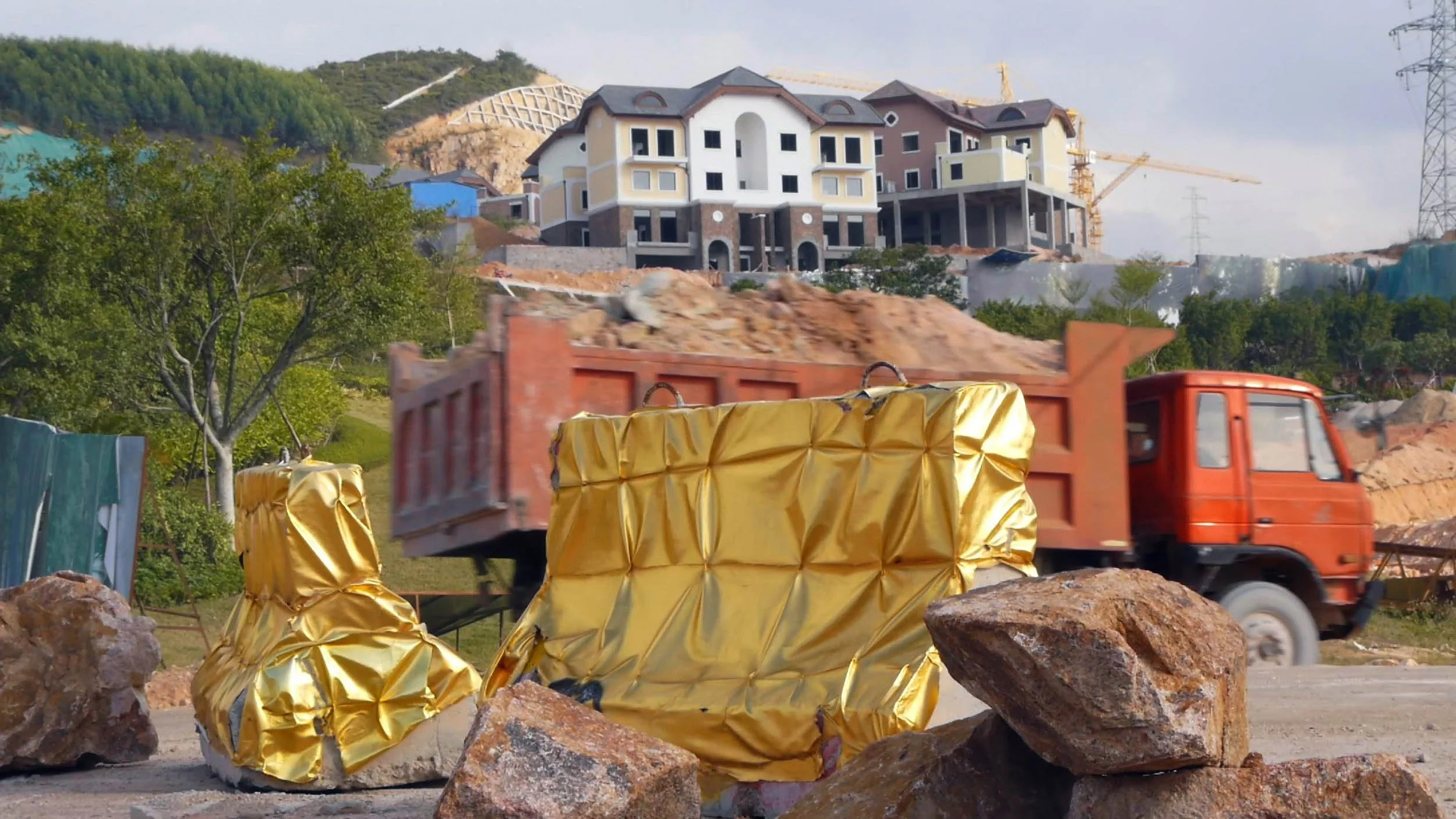MOUNTAIN VILLAGE
Sebastian Acker & Phil Thompson, 2017
30 min HD video, colour, stereo sound
Trailer
Still from video
Still from video
Still from video
Still from video
Still from video
Still from video
Mountain Village is the literal translation of the Chinese term Shanzhai, which in late-dynastic mythology referred to remote strongholds of bandits operating far from government control. Today, Shanzhai is the neologism for counterfeit products which replicate or appropriate branded consumer products. But Chinese copy culture isn’t limited to fake phones or computers. Recent years have also seen the Eiffel Tower, parts of the UK and even entire towns being replicated in China. These ‘copy towns’ are not theme parks but residential property developments built for actual communities.
The 30-minute video literally revolves around a famous mountain village: Hallstatt, Austria which was replicated in south Chinas Guangdong Province in 2012. The footage, which captures the property developments architecture and life along with its artificial lake and alpine backdrop, is juxtaposed with the Austrian original and several other simulacra across China: Thames Town near Shanghai, several Eiffel Towers and the Dafen Painting Village, where a large percentage of the worlds fake oil paintings are created.
» Sebastian Acker and Phil Thompson's video Mountain Village opens very appositely with a montage of images, making it markedly difficult for viewers, their gaze following a camera slowly gliding upwards in the lift in the Eiffel Tower, to differentiate the emblem of Paris from its copy in Hangzhou. But that is only the beginning of the confusing game. Are these Victorian streetscapes in London? Or is it façades from Thames Town in Sonjiang entering the picture? Are we right to have faith in the local colour represented by the Churchill statue or the red telephone boxes, or is it a question of an homage, rendered in sculpture, to the original? Do the layers of moss on the roof of the neo-gothic cathedral confirm that what we have here is a close up view of Christ Church in Bristol? Or is the copy of it already ageing somewhat and being covered in vegetation?
In Hallstatt, we can rely on the signage, the advertising, the contours of the mountains, the blueness of the lake and the signs of ageing in the buildings: that must be the Austrian village of 800 souls in the Salzkammergut, declared a world cultural heritage site by UNESCO. (…) However, the similarity between the model from Austria and its Chinese copy is not merely superficial; they are connected by more than what people generally think. Both the Hallstatt at the foot of the Dachstein mountain and the Hallstatt in Guangdong are reproductions of a past that never existed. Social and functional contexts, any consideration of the climate and the local circumstances are not desirable, either here or over there. Commerce rules, not community. That is what Dieter Wieland, long before the conquest by the triumphal march of globalised mass tourism, was already deeming the 'rustic con’.
But can a fake replication of a village, which has become a cliché, not also be a "prophetic vision of the past', and something which makes it easier for us to leave divisive national myths of origin behind? Then both Hallstatts should not be viewed as if something were being lost and abandoned, but rather as commonplace become reality: as 'places where one thought about the world is confirmed by another thought about the world', as the philosopher Éduard Glissant suggests. In this light, we may well anticipate the next chapter in this "story of translation belonging to cultural politics', to proliferate, as is its wont, in all directions. «
Prof. Dr. Annette Tietenberg
Excerpt from “A Prophetic Vision of the Past”
in Traces of Other Places (2021)
Mountain Village was screened at Institute of Contemporary Arts in London as part of London Short Film Festival (Diving Into a Teacup, 2018), Strelka Institute in Moscow (2018) and Acker & Thompson’s solo exhibition at Ravensburger Kunstverein (Mountain Village, 2017).
Sebastian Acker’s artist’s book Traces of Other Places, published by Kerber, Bielefeld/Berlin (2021) and supported by Stiftung Kunstfonds, continues the project and unites photographs, video stills and travel notes from the artists journeys.
Mountain Village
Sebastian Acker and Phil Thompson, 2017
30 min DCP/HD video, colour, stereo sound
Austria / China / France / UK
Language: English
Montage: Sebastian Acker
Colour grading: Ludovic Roussaux
Musical score: Benedict Drew
Sound design: Gernot Fuhrmann
Music: The Beautiful Blue Danube by Johann Strauss II, performed by the Strauss Festival Orchestra
Funded by Arts Council England and Ideas Tap, mentored by Mark Leckey.





